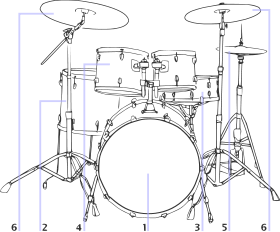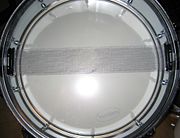Snare drum
| The drum kit |
 |
|
1 Bass drum | 2 Floor tom | 3 Snare 4 Toms | 5 Hi-hat | 6 Crash cymbal and Ride cymbal |
| Other components |
|
China cymbal | Splash cymbal | Sizzle cymbal |
The snare drum is a drum with strands of snares made of curled metal wire, metal cable, plastic cable, or gut cords stretched across the a drumhead, typically the bottom. Pipe and tabor and some military snare drums often have a second set of snares on the bottom (internal) side of the top (batter) head to make a "brighter" sound, and the Brazillian caixa commonly has snares on the top of the upper drumhead. The snare drum is considered one of the most important (if not the most important) drums of the drum kit.
Today in popular music, especially with rock drum kits, the snare drum is typically used to play a backbeat pattern[1] such as quarter notes on the backbeat or the slightly more interesting: also sometimes in slow band songs they use a brush to touch the snare instead of hitting it with a wooden drum stick.
Contents |
Operation

The drum can be sounded by hitting it with a drumstick or any other form of beater, including brushes and rutes, which produce a softer-sounding vibration from the wires. When using a stick, the drummer may strike either the head of the drum, the rim, or the shell. When the top head is struck the snares vibrate against the bottom head producing a cracking sound. The snares can often be thrown off with a lever on the strainer so that the drum only produces a tom-tom sound.[2] Rim shots are a technique associated with snare drums in which the head and rim are struck simultaneously with one stick (or in concert playing, a stick placed on the head and rim struck by the opposite stick), and rudiments are sets of basic patterns often played on a snare drum. [3]
Snare drums may be made from various wood, metal, or acrylic materials. A typical diameter for snare drums is 14 inches. Marching snare drums are deeper in size than snare drums normally used for orchestral or drum kit purposes, often measuring in at a foot long. Orchestral and drum set snare drum shells are about 6 inches deep. Piccolo snare drums are even more shallow at about 3 inches deep. Soprano, popcorn, and firecracker snare drums have diameters as small as 8 inches and are often used for higher-pitched special effects.[4]
Wood shell construction
Most snare drums are constructed in plies that are heat- and compression-molded into a cylinder. Steam-bent shells consist of one ply of wood that is gradually rounded into a cylinder and glued at one seam. Reinforcement hoops are generally needed on the inside surface of the drum to keep it perfectly round. Segment shells are made of multiple stacks of segmented wood rings. The segments are glued together and rounded out by a lathe. Similarly, stave shells are constructed of vertically glued pieces of wood into a cylinder (much like a barrel) that is also rounded out by a lathe. Solid shells are constructed of one solid piece of hollowed wood.
See also
Snare drum hardware
References
- ↑ 1.0 1.1 Schroedl, Scott (2001). Play Drums Today!, p.11. Hal Leonard. ISBN 0-634-02185-0.
- ↑ Pearl Drums
- ↑ Vic Firth
- ↑ Pearl Drums
External links
- Marching Snare Drum Heads - Description of types of marching snare drum heads.
- Royal Schools Sources Percussion Page Sources for the prescribed music for the Royal Schools of Music practical exams
- Field Drums Blog Photos, information, critical commentary and analysis of field drums, focusing on drums of the American Civil War
|
|||||||||||